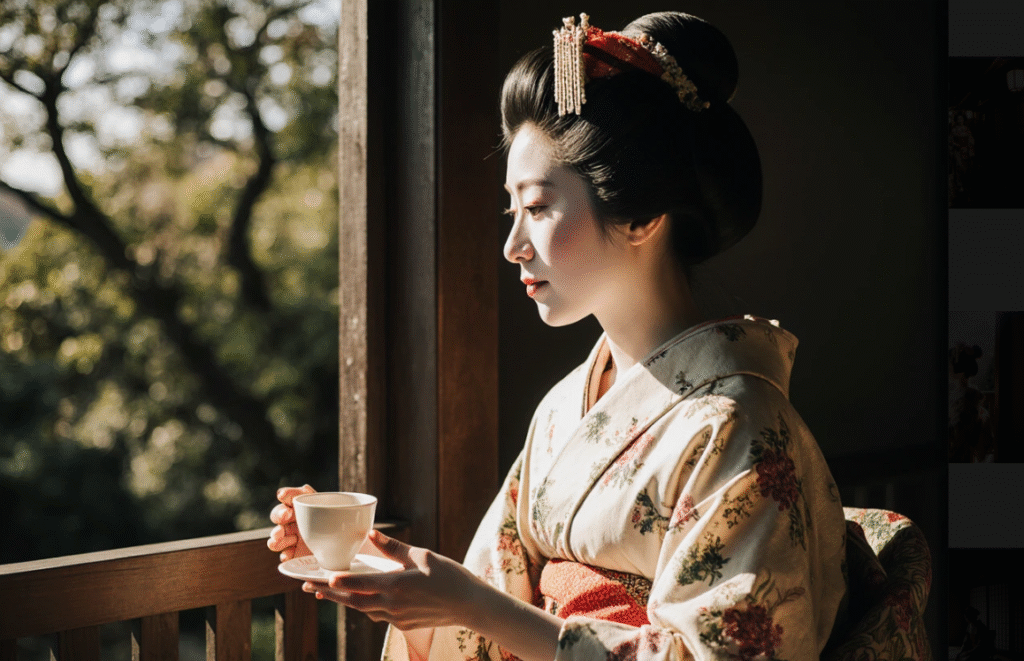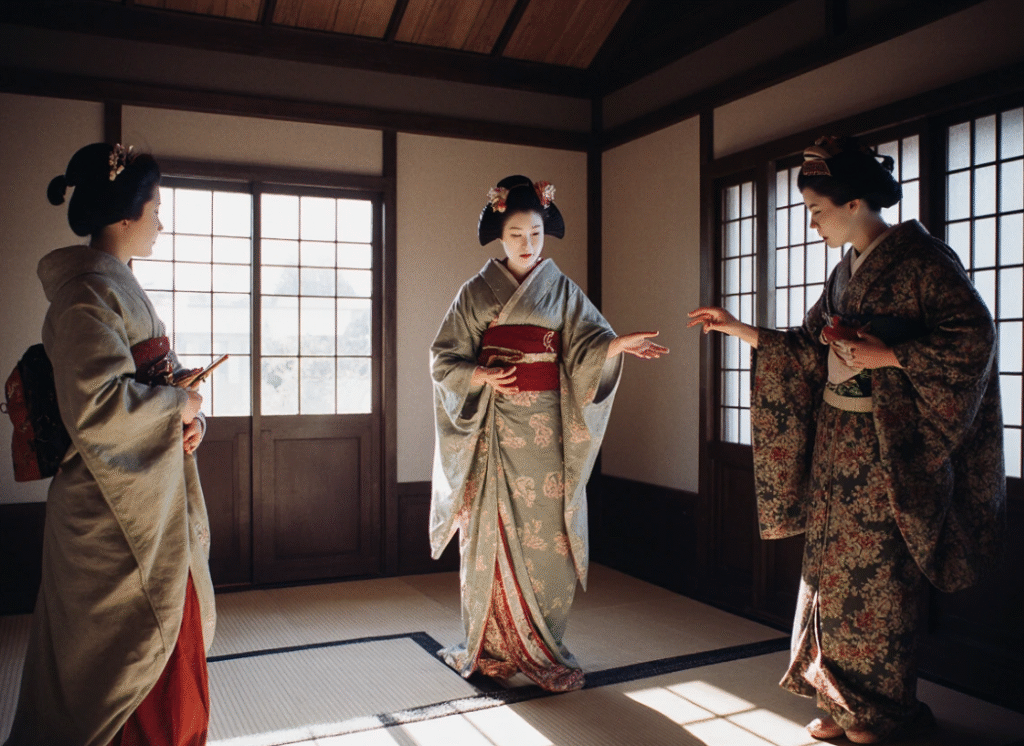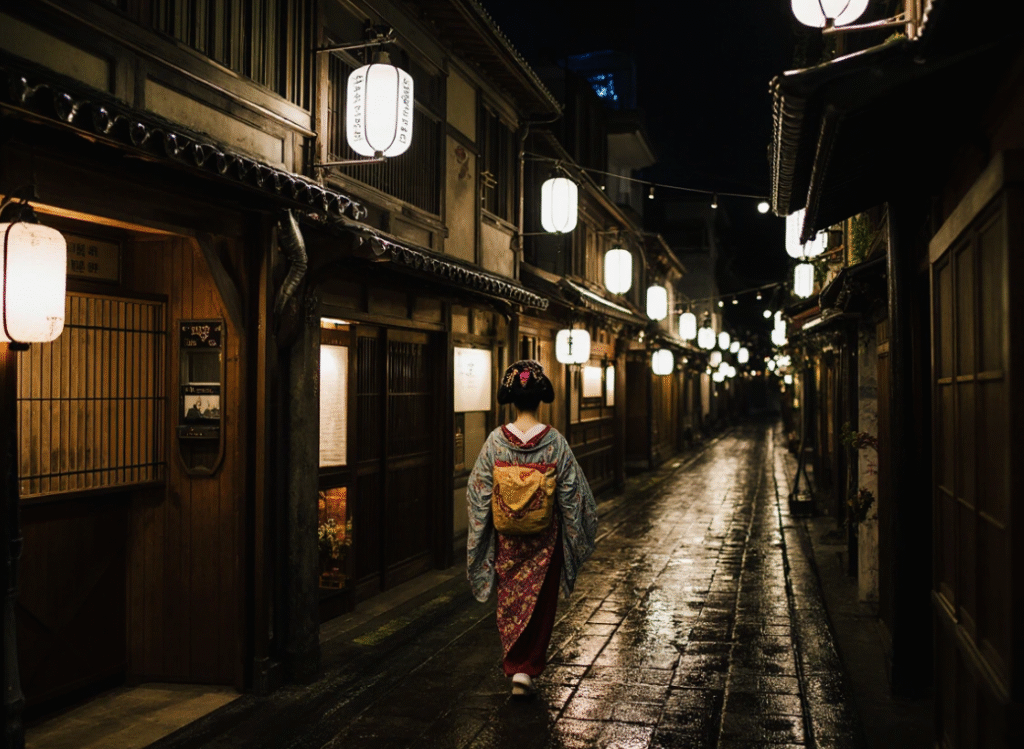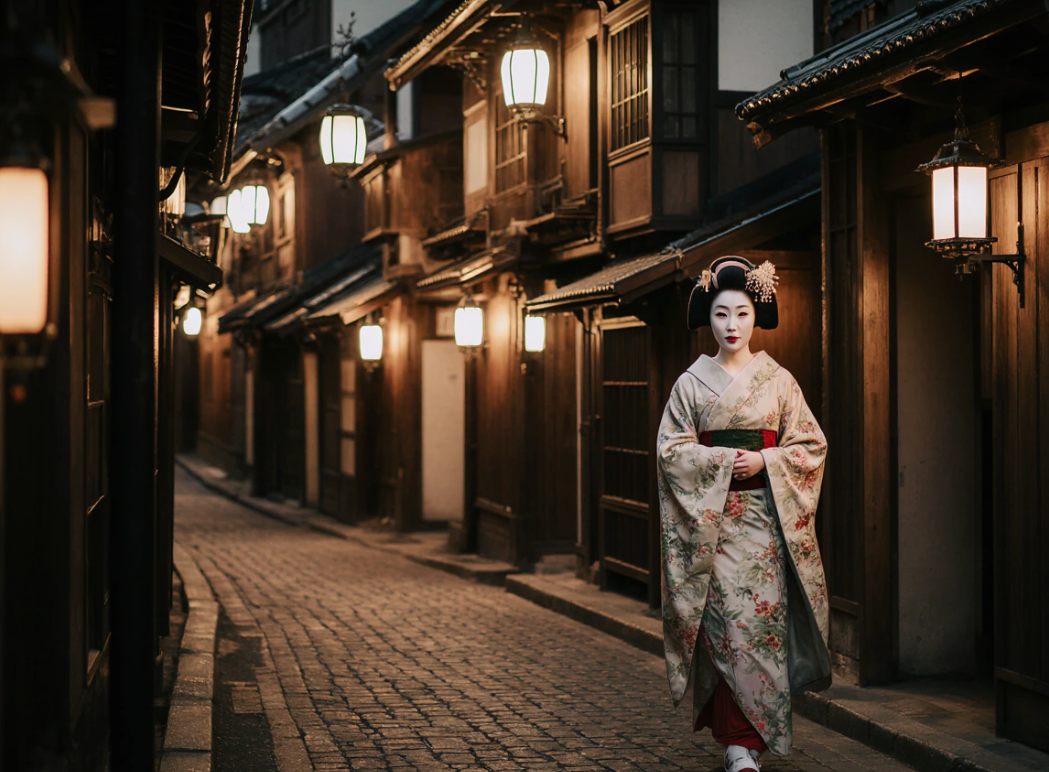Walk down Pontocho on any evening and you might catch a glimpse of something magical: a maiko hurrying to an appointment in her bright kimono, her elaborate hairpins catching the lantern light. It looks like a scene from another century. That’s because, in many ways, it is.
More about Pontocho:
- Pontocho Park Guided Tours
- The Complete Guide to Pontocho: Kyoto’s Most Atmospheric Alley
- Kamogawa Odori Dance Performance: Complete Attendance Guide
- Pontocho Kobu Kaburenjo Theater
What Makes the Geisha District Pontocho Different from Other Hanamachi?
Pontocho is one of five geisha districts in Kyoto, but it has its own character. The narrow alley runs along the Kamogawa River from Shijo-dori to Sanjo-dori. Red lanterns light the stone pavement at night. The buildings squeeze together in what locals call the “eel bed” design—narrow fronts that stretch deep into the block.
Currently, 38 geisha and maiko work in Pontocho. That’s a small group keeping a centuries-old tradition alive. While Gion gets more attention from tourists, Pontocho remains quieter and more intimate. The district has held onto its character partly because many establishments still operate on the old ochaya system—teahouses that require introductions from existing patrons.
How Pontocho Changed from Sandbar to Entertainment District
Four hundred years ago, Pontocho didn’t exist. The area was part of the Kamogawa River until 1670, when levee protection work landfilled the area. The Edo government needed stronger riverbanks. The construction created new land between the Kamo and Takase rivers.
Within decades, the area transformed. Geiko and maiko have existed in Pontocho since at least the 16th century. Tea houses appeared. Entertainment venues followed. The highly stylized dance-drama of Kabuki is said to have originated here. By 1712, Pontocho operated as a licensed entertainment district.

The Kamogawa Odori dance performance was established in 1872. This annual spring event became a showcase for Pontocho’s geisha and maiko. The tradition continued through the Meiji Era and World War II, and from 1951 to 1998, performances happened twice a year. Today, Pontocho boasts over 184 performances, the greatest number among Kyoto’s five hanamachi districts.
Here’s what could have happened differently: Pontocho might have become a purely commercial district like so many other reclaimed areas. Without the early establishment of the ochaya system and the patronage networks that came with it, the area could have lost its entertainment character entirely. Instead, the introduction system created a barrier that protected the district’s traditions, even as Kyoto modernized around it.
Understanding the Pontocho Okiya: The Heart of Geisha Training
An okiya is where a maiko’s journey begins and often where it remains centered throughout her career. The Pontocho Okiya is run by the “mother” (okā-san) of the house, who handles a geisha’s engagements, the development of her skills, and funds her training.
Think of the okiya like a specialized trade guild combined with a family business. The okā-san acts as mentor, manager, and guardian all at once. A geisha is legally required to be registered to an okiya in order to work. This registration isn’t just paperwork—it connects the geisha to a network of relationships, traditions, and opportunities that define her career.

An okiya and its attached teahouse typically has its own “branch” of art names linking its geisha and maiko together, usually through the use of a shared prefix. For example, many of the geisha trained at the Dai-Ichi teahouse in Pontocho have names that begin with Ichi-. Your name tells insiders exactly where you trained and who your artistic lineage connects to.
The financial arrangements vary. A geisha may start her career by borrowing everything from her okiya, including room and board and her kimono, and may pay this back over time. Under this system, until a geisha’s debt is paid off—a process that takes roughly two years—all of her tips and wages go to the okiya, who then give her an allowance in return.
Alternatively, a geisha may begin as an “independent” (jimae) geisha, who buys her own kimono, chooses to live separately from the okiya, and pays only for the fee of affiliation to the house.
Living and Training in Geisha Houses Pontocho
Daily life in an okiya follows strict rhythms. Daily routines include lessons in traditional arts, preparation for performances, and household duties for the maiko. Geishas and maiko often share close bonds within the okiya, supporting each other through the challenges of their profession.
- The okā-san’s role extends beyond management. The okasan covers the costs of the maiko’s training, attire, and living expenses, creating a sense of responsibility and loyalty within the house. She enforces discipline, books engagements, and gradually introduces her maiko to the exclusive world of teahouses and patrons.
- The okāsan also provides meals and clothes for the residents of the okiya. A percentage of a geisha’s earnings will go to maintaining the household and supporting the people who live there, including retired geisha and maids.
Succession in the okiya follows an adoption system. When the owner of an okiya retires, she may name one of her natural daughters or one of the geisha under her as the heir (atotori) of the house; in the case of the atotori not being related to the mother of the house, the heir is adopted as the mother’s daughter. Under this arrangement, a geisha’s debts are absorbed by the okiya, with all the money she earns going to the establishment directly as the new owner and proprietor.
The Path from Shikomi to Geiko: How Maiko Pontocho Training Actually Works
Young girls who dream of becoming a maiko choose to enter a geisha house after graduating from junior high school, usually at age 15-16. The process starts with an interview. The woman in question will be interviewed by the proprietress of an okiya to see whether or not she’s serious about this line of work.
- Once accepted, she becomes a shikomi. This stage of training will last for approximately one year. During this time the young women will take lessons in dance and music, learn how to wear kimono, and speak in the special dialect of Kyoto known as Kyo Ben.
- Life as a shikomi means hard work before any glamour. She does household chores, attends intensive lessons, and observes everything. She watches how older maiko and geiko move, speak, and interact with patrons.
- After the shikomi period comes the official debut as a maiko. Young ladies, usually between the ages of 15 and 20, train for five years to become a geiko. The transformation into a geiko happens around age 20-21. When maiko reaches the age of 20-21, her art masters and the owner of okiya decide if she’s ready to progress into the geiko stage. There’s no official exam, they just have to give her a green light to go further.
- The transition ceremony requires mastering specific performances. Upon becoming a geiko, a maiko has to master “Kurokami” (“Jet Black Hair”) dance which she will perform during her sakko.
The Visual Differences: Geiko vs Maiko Pontocho
Maiko wear colorful kimono with long sleeves and appear with their own hair worn up with a variety of extravagant hairpins (known as kanzashi), while geiko wear plainer kimono with shorter sleeves and appear wearing relatively unadorned wigs.
This distinction matters. A maiko’s elaborate hairstyle takes hours to create and must be maintained for days. She sleeps on a special wooden pillow (takamakura) to preserve it. A geiko wears a wig because many geisha start losing their hair at an early age because of too much pulling as part of the intricate hairstyles.
“The kimono a maiko wears can cost as much as a car. The silk alone represents hundreds of hours of specialized work. When you see a maiko walking to an engagement, you’re watching someone carry the equivalent of a small house deposit on her back. This is why the okiya system exists—no 16-year-old could afford this investment alone.”
Kyoto Geisha Etiquette: Rules Every Visitor to Pontocho Must Know
The romance of seeing geisha in Pontocho walking through lantern-lit alleys has created problems. In 2019, there were reports of badly behaved visitors tugging at women’s kimonos, chasing them around with cameras and smartphones, pulling out their hair ornaments (kanzashi) and even hitting them with cigarette butts.

Gion began putting up signs prohibiting photography, warning that violators would face a fine of ¥10,000 ($92). While Pontocho hasn’t implemented the same strict ban, the same respect applies.
The Geisha Etiquette Photography Problem
When you spot maiko walking down the street, they are on the clock. These girls have no time whatsoever to pose for free in the middle of the road. Understand that their clients start paying them from the moment they step out of their house as they walk towards the meeting location. Stopping a maiko for a photo means you’re wasting their patron’s money—and potentially damaging the maiko’s reputation with that patron.
The basic rules are simple:
- Do not stop, touch, or follow any geiko or maiko you see
- Do not take photographs without permission
- Do not block their path or entrance to ochaya
- Do not speak to them when they’re clearly working
- Give them space to move freely through the streets
What You Should Do Instead
To experience geisha entertainment firsthand, consider attending one of the public Kamogawa Odori performances held at the Kaburenjo Theater in May. Tickets range from ¥5,000 for unreserved seats to ¥10,000 for reserved seats.
For a more intimate experience, private geisha entertainment starts at ¥78,000 per group, plus ¥22,000 per person for dinner as of June 2024. These private dinners happen at kaiseki restaurants with bilingual interpreters, allowing real conversation and cultural exchange.
If you see a maiko or geiko on the street, you can smile and give a polite bow. Then let them continue their engagement. That moment of acknowledgment shows respect without interference.
“I tell visitors to think of it like this: if you saw a surgeon rushing into an emergency room, would you chase them for a selfie? Geisha and maiko are professionals heading to work. The kimono and makeup don’t change that basic fact. Show the same respect you’d show any working professional.”
The Modern Reality: What Happens to Most Maiko?
Most maiko do not become full-fledged geisha. They quit at the end of the maiko period. The reasons vary. Some find the lifestyle too restrictive. Others want to marry. Geisha of Kyoto cannot get married. The rule of this profession is “being married to the art, not a man”.
For those who chose to be a geisha, it is a lifetime profession though so many geisha eventually quit in their thirties and forties and become housewives. If they don’t quit, most geisha become an okiya owner or inherit the okiya they are affiliated with and run a geisha house.
Comparing Pontocho to Other Geisha Districts
| District | Number of Geisha/Maiko | Tourist Accessibility | Main Dance Event | Photography Rules | Atmosphere |
| Pontocho | 38 (combined) | Moderate | Kamogawa Odori (May) | Discouraged, no formal ban | Intimate, quieter |
| Gion Kobu | Approximately 100 | High | Miyako Odori (April) | Banned on private streets, ¥10,000 fine | Tourist-heavy, traditional |
| Miyagawa-cho | Approximately 60 | Moderate | Kyo Odori (April) | Discouraged | Residential, authentic |
| Kamishichiken | Approximately 25 | Low | Kitano Odori (April) | Discouraged | Exclusive, local |
| Gion Higashi | Approximately 15 | Low | Gion Odori (November) | Discouraged | Smallest, traditional |
What Tourists Get Wrong About Pontocho
The three most common mistakes visitors make reveal fundamental misunderstandings about geisha culture.
Mistake 1: Treating daytime “maiko” as real geisha
You’ll see women in elaborate makeup and kimonos posing for photos near temples during the day. These are almost certainly tourists who have paid to be made up and dressed like geisha. Real maiko and geiko work at night, heading to private engagements.
- Why tourists do this: The transformation photos look impressive on social media, and the services cost $100-200. That seems like an affordable way to experience geisha culture.
- The cost of this mistake: You might post photos thinking you’ve met a geisha, spreading misinformation about when and where geisha actually appear. Time spent: 2-3 hours. Money spent: $150-250 on average. Cultural understanding gained: minimal, as the experience focuses on external appearance rather than the arts and traditions.
Mistake 2: Expecting to enter any teahouse in Pontocho
Tourists walk up to ochaya doors and expect to be welcomed inside for dinner. Most find the doors locked or receive polite refusals.
- Why tourists do this: Many travel guides mention Pontocho’s traditional teahouses, and the restaurants look beautiful from outside.
- The cost of this mistake: The ochaya system requires introductions from existing patrons. These restaurants often require introductions and reservations well in advance. Walking up without connections means rejection, disappointment, and possibly feeling deceived about Pontocho being “accessible.” Some tourists then leave bad reviews online, not understanding they attempted to enter private establishments. Result: Wasted evening plans and frustration with a system they didn’t research.
Mistake 3: Visiting only during the day or late at night
Tourists arrive at 2 PM or after 10 PM and wonder why Pontocho seems empty or closed.
- Why tourists do this: They combine Pontocho with daytime temple visits or assume nightlife means late hours like Western bars.
- The cost of this mistake: Due to the impact of COVID-19, operating hours have been shortened, and now many shops close around 10 PM. It’s best to arrive around 5:30 PM to 6 PM, considering the time you might spend waiting in line. Arriving at the wrong time means missing both dinner opportunities and any chance of glimpsing maiko heading to work. Time wasted: potentially a full evening. Opportunity lost: the specific 6-8 PM window when maiko are most visible on the streets.
For Whom Pontocho Might Not Be the Right Choice
Pontocho deserves its reputation, but it won’t satisfy every traveler. Here’s the honest assessment.
- If you expect easy, affordable access to geisha entertainment, Pontocho will frustrate you. Private geisha entertainment starts at ¥78,000 per group plus dinner costs. Public performances at Kaburenjo Theater happen only twice yearly. Most ochaya require introductions. Budget travelers looking for a $50 geisha experience won’t find it here.
- If you need English everywhere, Pontocho presents challenges. Many traditional establishments operate in Japanese only. However, many restaurants welcome tourists and offer English menus—but these are typically the newer, more commercial venues rather than the historic ochaya.
- If you want Instagram opportunities with geisha, this isn’t your district. The photography bans and etiquette rules mean you’re more likely to get stern warnings than photos. Tourists seeking social media content should consider paid geisha transformation experiences instead.
- If you’re traveling with young children or need wheelchair accessibility, the narrow alley and traditional buildings create difficulties. Most venues have steep stairs, small spaces, and formal atmospheres unsuitable for kids.
That said, for travelers interested in authentic cultural preservation, patient observation, and accepting traditional Japanese boundaries around privacy and introduction systems, Pontocho offers something increasingly rare: a working entertainment district that hasn’t sacrificed its traditions for tourist convenience.
Lesser-Known Facts About Pontocho Life
Understanding Pontocho requires knowing details that don’t appear in guidebooks.
- The seasonal transformation of kawayuka dining: From May to September, many restaurants construct temporary platforms (yuka) over the Kamogawa River. This isn’t just about the atmosphere. The platforms solve a practical problem—Kyoto’s summer heat and humidity make indoor dining uncomfortable in buildings without modern air conditioning. The tradition dates back centuries as a way to catch river breezes while maintaining the formal dining experience.
- The hidden training schedule: While tourists see maiko only at night, their actual work starts at dawn. A typical day includes tea ceremony lessons at 7 AM, shamisen practice at 9 AM, dance training at 11 AM, vocal training at 2 PM, and preparation time starting at 4 PM for evening engagements. Maiko usually live at their okiya during their training period, under the care of a kami-san. During this time, they are not supposed to enter into romantic relationships or marry.
- The economics of a single kimono: A maiko’s formal kimono costs ¥3-5 million ($20,000-$33,000). The obi (belt) adds another ¥1-2 million. Kanzashi hairpins run ¥100,000-500,000 per set. A maiko needs multiple complete outfits for different seasons and occasions. Without the Pontocho Okiya system funding these costs, the profession would be economically impossible for young women from normal backgrounds.
- The district’s symbol holds practical meaning: The symbol of Pontocho, found on the beautiful lanterns that line the street, is a plover (shidori), a small bird commonly found on the shores of the Kamo River. This isn’t arbitrary symbolism. The plover (chidori) represents the district’s origins as reclaimed riverbank land and serves as a recognizable emblem that distinguishes Pontocho from other districts, each with their own crests.
The Kamogawa Odori performances have attracted overseas celebrities such as Jean Cocteau and Charlie Chaplin: This international attention helped establish Pontocho’s reputation beyond Japan while maintaining artistic integrity rather than commercializing for foreign audiences.
How to Experience Pontocho Hanamachi Respectfully and Meaningfully
The best way to visit Pontocho is to arrive with no agenda beyond observation. Walk the alley at dusk, around 6 PM. Choose a restaurant within your budget—options range from ¥3,000 yakitori stands to ¥20,000+ kaiseki experiences. Sit at a riverside table if possible. Eat slowly. Watch the street.
If you’re genuinely interested in geisha culture, plan your Kyoto visit around one of the annual dance performances. Book tickets months in advance for the May Kamogawa Odori or October Suimeikai. These performances let you see what Pontocho Maiko and Geiko actually train for—not their commute to work, but their art itself.

Consider booking a small group geisha experience through verified cultural organizations. These arrange appropriate settings where photography and questions are welcomed rather than intrusive. The price reflects the reality that you’re paying for professional entertainers’ time and expertise.
Most importantly, remember that Pontocho isn’t a theme park. It’s a neighborhood where people live and work. The fact that their work involves maintaining centuries-old artistic traditions doesn’t make them public property. The greatest respect you can show is treating Pontocho Geisha and Maiko as you would any skilled professional: with appropriate distance, genuine appreciation for their craft, and willingness to experience their art on their terms rather than yours.
The lanterns will glow regardless of whether you get a perfect photo. The traditions will continue whether you gain Instagram content or not. Pontocho’s value lies not in what you can extract from it, but in the fact that it exists at all—a living connection to Kyoto’s past, persisting against economic and cultural pressures that have erased similar districts throughout Japan. Your visit should acknowledge and support that preservation, not threaten it.
